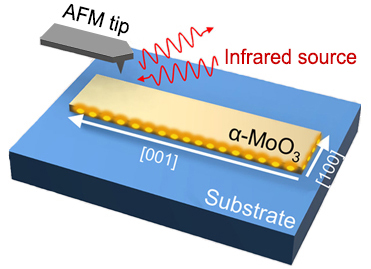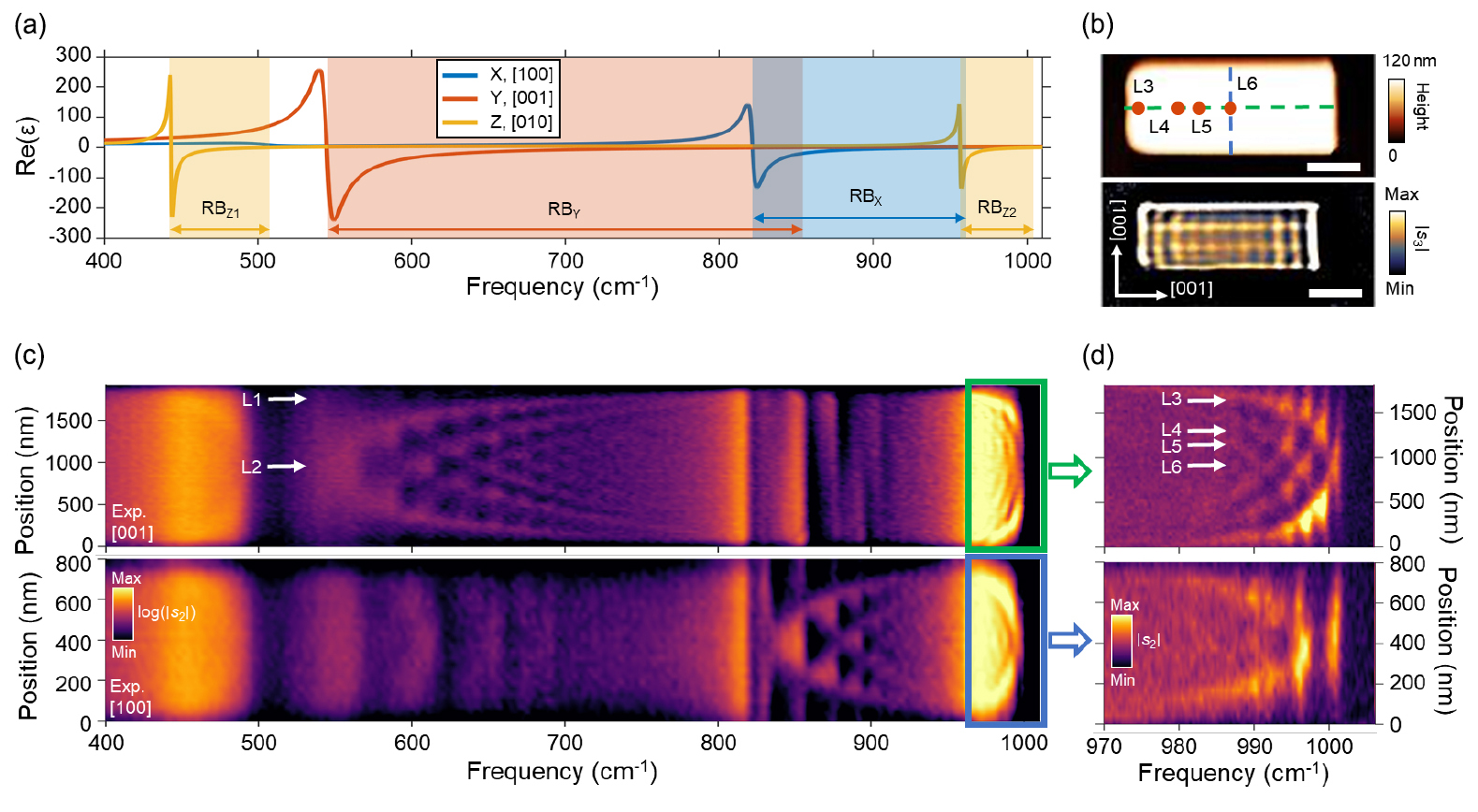SCIENTIFIC ACHIEVEMENT
Using the Advanced Light Source (ALS), researchers found that ribbon-like thin films, grown through a bottom-up, self-assembly approach, can act as ultrahigh-quality nanoscale resonators of lattice vibrations at infrared frequencies.
SIGNIFICANCE AND IMPACT
These ultrathin nanostructures are ideal platforms for applications that harness infrared light, such as thermal emission and molecular sensing.

Crystals that vibe with infrared light
Optoelectronic devices combine electronics with optical (light-based) phenomena such as reflection, refraction, and interference. By exploiting these unique properties of light, optoelectronic devices can be small, fast, and extremely sensitive to subtle changes in their surroundings. For light in the infrared regime, applications include systems for subwavelength imaging, thermal emission, and molecular sensing.
Because infrared wavelengths are relatively long (generally on the order of microns), scientists need a way to downsize the light in order to work with device components at the nanoscale. Some thin-film nanostructures, called van der Waals (vdW) materials, effectively compress infrared wavelengths up to hundreds of times. These materials support strong resonances between infrared photons and crystal-lattice vibrations (phonons), effectively forming hybrid photon–phonon quasiparticles known as phonon polaritons. The vdW materials that support phonon polaritons possess extraordinary light-confinement capabilities, but to be fully utilized, they require defect-free crystallinity and nanostructured form factors.
Scalable synthesis of nanoresonators
In this work, researchers synthesized phonon polaritonic vdW materials with tailorable morphologies and crystal qualities consistent with bulk single crystals. The bottom-up, self-assembly approach they developed—flame vapor deposition (FVD)—is noteworthy for its rapid growth rates, low cost, high scalability, and atmospheric operating conditions. It represents a significant advance over current mechanical exfoliation methods, which are labor intensive and unsystematic, or slower vapor deposition techniques that are costly and require potentially damaging lithography treatments.

Using FVD, the group was able to grow microplates, nanoribbons, and nanowires of molybdenum oxide (MoO3), a particularly interesting vdW phonon polaritonic material exhibiting properties potentially useful for tuning and routing polaritons. Sample morphology was controlled through variations in temperature, molybdenum concentration, and time. The nanoribbons, having exceptionally smooth, parallel edges that act as reflecting surfaces, naturally function as ideal resonating cavities for infrared phonon polariton standing waves. Probing these resonances with synchrotron infrared nanospectroscopy (SINS) provided a way to measure the quality of these nanoresonators.
Resonance mapping with SINS
The broadband IR light provided by ALS Beamline 2.4 enabled the researchers to map phonon polariton resonances spanning mid- to far-IR wavelengths, covering four distinct frequency bands (Reststrahlen bands) where resonances occur. The beamline’s unique far-IR photodetector was key to collecting data at the lowest-energy band. In addition, the researchers used Beamline 5.4, which covers the mid-IR range as well but with much higher spectral resolution than found in typical commercial systems—by almost a factor of 10.
The resulting resonance maps fully characterize for the first time the broadband infrared response of FVD-synthesized MoO3 nanoribbons along the two in-plane axes, detecting resonance modes beyond the 10th order. The resonances are much stronger and more discernible than those from nanostructures prepared using alternative methods.
A measure of resonator quality can be derived by taking crosscuts of the experimental data (along constant x- or y-positions) and fitting them with multiple Lorentzian peaks (a standard shape for spectral lines). The quality factors (Q-factors) thus obtained are the highest reported for a phonon polariton resonator to date—clear evidence of the high crystal quality of the synthesized nanoribbons. In sum, bottom-up-synthesized polaritonic vdW nanostructures are good prospects for high-performance, low-loss infrared optical and optoelectronic applications.

Contacts: Shang-Jie Yu and Yue Jiang
Researchers: S.-J. Yu, Y. Jiang, J.A. Roberts, M.A. Huber, H. Yao, X. Shi, T.F. Heinz, X. Zheng, and J.A. Fan (Stanford University); and H.A. Bechtel and S.N. Gilbert Corder (ALS).
Funding: National Science Foundation, Air Force Office of Scientific Research, Packard Fellowship Foundation, National Defense Science and Engineering Graduate Fellowship Program, and U.S. Department of Energy, Office of Science, Basic Energy Sciences program (DOE BES). Operation of the ALS is supported by DOE BES.
Publication: S.-J. Yu, Y. Jiang, J.A. Roberts, M.A. Huber, H. Yao, X. Shi, H.A. Bechtel, S.N. Gilbert Corder, T.F. Heinz, X. Zheng, and J.A. Fan, “Ultrahigh-Quality Infrared Polaritonic Resonators Based on Bottom-Up-Synthesized van der Waals Nanoribbons,” ACS Nano 16, 3027 (2022), doi:10.1021/acsnano.1c10489.
ALS SCIENCE HIGHLIGHT #462